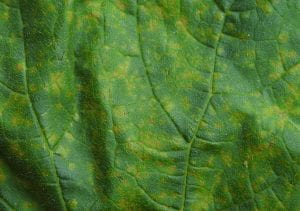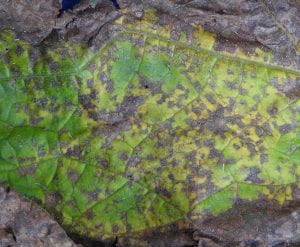Updated June 2022
Printer-friendly .pdf versions of the management information on this page are available below. There are two versions because some pesticides are not permitted to be used on Long Island due to their potential to leach through sandy soils and reach the freshwater in Long Island’s aquifer system which is the sole source of drinking water for residents.
Management guidelines for: Long Island, N.Y. | Elsewhere.
Producing a high-quality cucurbit crop necessitates effectively managing downy mildew. This foliar disease is common in the northeast because the pathogen produces a large quantity of asexual spores that are easily dispersed long distances by wind, which enables it to spread widely. The pathogen does not affect fruit directly; however, affected leaves die prematurely which results in fewer fruit and/or fruit of low quality (misshapen cucumbers, poor flavor, sunscald, poor storability).
Experiments are conducted routinely at LIHREC to determine efficacy of fungicides and resistant cucumber varieties, which are the main management tools for downy mildew. Efficacy is examined for new fungicides and registered fungicides that are at risk for resistance development to assess whether resistant pathogen strains are present and impacting control. Two approaches are used. Fungicide evaluations entail applying fungicide treatments weekly to field-grown plants in a replicated experiment. The main approach used recently is a seedling bioassay, which entails treating potted plants at the 2- to 4-leaf stage with different fungicides, exposing them to the downy mildew pathogen by putting them next to infected field-grown plants, then keeping them in a greenhouse until downy mildew develops and severity is rated. Another activity is monitoring occurrence of this disease on different cucurbit crop types by planting sentinel plots. There are several pathotypes of this pathogen that differ in the cucurbit type they can infect. Those able to infect cucumber have been most common on Long Island. Similar research on management is also being conducted at other universities in the USA. The overall goal of this work is to obtain information needed to guide recommendations for growers.
Topics on this page:
- Examples of Symptoms on Pumpkin Leaves
- Fungicides
- Resistant varieties
- Guidelines on Managing Cucurbit Downy Mildew
Examples of Symptoms on Pumpkin Leaves
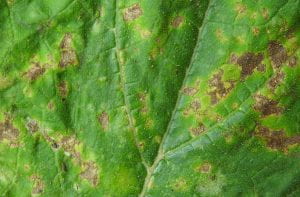
Fungicides
The most important component of an effective management program for downy mildew is an effective, properly-timed fungicide program. And the key to that is applying mobile fungicides targeted to the pathogen starting when there is a risk of the pathogen being present. Risk is predicted at the Cucurbit Downy Mildew Forecast website for this disease. Mobile (or translaminar) fungicides are needed for control on the underside of leaves. Each year there can be changes to the fungicides recommended as the pathogen develops resistance or new products are registered. Because these fungicides have targeted activity, additional fungicides must be added to the program when there is a need to manage other diseases such as powdery mildew. Most targeted fungicides effective for downy mildew are also effective for Phytophthora blight.
There are products labeled for cucurbit downy mildew with ingredients in 11 fungicide chemical groups (designated by FRAC code) that have targeted activity and thus are considered at risk for resistance development (see table and list below on this page). There are also protectant fungicides (mancozeb and chlorothalonil) recommended used alone preventively and when downy mildew is present tank-mixed with the targeted fungicides for managing resistance. Based on results of the seedling bioassay conducted at LIHREC the past four seasons (see table), the most effective fungicides are Orondis (the newest fungicide), Omega, Ranman and Zing! (thus also Gavel which has the same targeted active ingredient). Curzate (thus also Tanos) and Previcur Flex were effective every year except 2017. Effective control was achieved in only one year with Forum (2018) and Presidio (2017). Quadris and Revus were consistently ineffective. Similar results were obtained in other states where the bioassay was conducted. All of these fungicides effectively controlled downy mildew in the past, so poor performance of some in these recent studies is considered to be due to fungicide resistance. Pathogen resistance has been confirmed in the USA to FRAC Codes 4, 11, 28, 40, and 43 through laboratory research. Most research, including at LIHREC, has been with cucumber. Resistance is now thought to be a greater issue with cucumber than some other cucurbit crop types reflecting the fact this pathogen exists as two clades and pathotypes within each that differ in their ability to infect the various cucurbit crop types. Lineage 1 pathotypes infect cucumber, pumpkin and cantaloupe. Lineage 2 pathotypes infect squashes and watermelon. A recent in-depth study revealed frequency of resistance to Previcur Flex and Presidio was higher in isolates from cucumber than other cucurbits. Revus was effective applied to pumpkin but not cucumber in adjacent fungicide evaluations in Virginia. While fungicides ineffective in the bioassays conducted with cucumber might be effective applied to other cucurbits, no or limited use is recommended for downy mildew on these crops to minimize selection pressure for resistance to develop.
Determining efficacy of individual fungicides was the goal of two experiments with field-grown cucumber conducted in 2019 at universities in North Carolina (NC) and Georgia (GA). Revus was ineffective in GA and among the least effective in NC. Orondis was tested in GA and was the most effective fungicide. Ranman provided good control in both experiments. Other fungicides tested that were effective include Previcur Flex, Curzate or Tanos, Gavel, Zing!, Presidio, and Elumin. Testing a new experimental fungicide alone and in programs with other fungicides was the focus of the experiment conducted at LIHREC in 2019. The ‘grower standard program’ was among the most effective treatments providing 70% control. It was Manzate Pro-Stick applied weekly before symptoms were seen (3 applications) followed by Orondis Opti, Zing!, and then Ranman.
- Table of Mobile Fungicides for Mildews and Phytophthora Blight that includes their seasonal use limit, REI and PHI.
Resistant varieties
Resistance was the main tool for cucumbers until a new strain of the pathogen developed. Since 2004, varieties with this resistance, which include most hybrids, have provided some suppression of the new pathogen strains present, but substantially less than the excellent suppression that was achieved against strains present before 2004. However, these resistant varieties are still considered a worthwhile component of an integrated program. Fortunately, new sources of resistance have been found and cucumber varieties with these new genes for resistance are starting to become available. In a cucumber variety evaluation conducted at LIHREC in 2017, DMR 401 exhibited the highest level of resistance. Bristol and Citadel (pickling type suitable for fresh market) were moderately resistant but were not significantly less severely affected than SV3462CS, SV4719CS, and Diamondback. Marketmore 76 exhibited limited resistance while Speedway was not significantly less severely affected than Straight Eight, the susceptible check variety. DMR 401, Bristol and Citadel were also the highest yielding varieties. DMR 401 was developed by Cornell plant breeders. In evaluations conducted in 2016 and 2017 at University of Massachusetts, NY264, DMR 401 (both sold at Common Wealth Seeds), and Bristol exhibited good resistance with NY264 and Bristol performing best under high disease pressure.
Guidelines on Managing Cucurbit Downy Mildew
1. Select resistant cucumber varieties.
2. Sign up to receive alerts about downy mildew occurrence and routinely check the Cucurbit Downy Mildew Forecast website to know where the disease is occurring and what crops are affected.
The forecast web site is an important tool for determining when fungicide applications are warranted. Cucurbit plants are susceptible to downy mildew from emergence; however, this disease usually does not start to develop in the northeast until later in crop development when the pathogen is dispersed by wind into the region. The forecast program monitors where the disease occurs and predicts where the pathogen likely will be successfully spread. The pathogen is thought to only be able to survive over winter in southern Florida, and from there spreads northward. There has been no evidence that the pathogen is surviving between growing seasons where winter temperatures kill cucurbit crops (outdoors above the 30th latitude); however, recently both mating types have been found, but on different cucurbit crop types (Lineage 1 pathotypes are A1 mating type and Lineage 2 pathotypes are A2), thus there is the potential for the pathogen to produce oospores (sexual spores) that could enable the pathogen to survive in northern areas of the USA.
The risk of downy mildew occurring anywhere in the eastern USA is forecast and posted three times a week. Forecasts enable timely fungicide applications. Growers can subscribe to receive customizable alerts by e-mail or text message. Information is also maintained at the forecast web site of cucurbit crop types being affected by downy mildew, which is important because of pathogen specialization. When risk is forecasted for the area where you are growing, look to see if the same or related cucurbit crop types (same Latin name; see table below) are affected in the trajectory path to determine if your specific crops are at risk. Success of the forecast system depends on knowledge of where downy mildew is occurring; therefore, prompt reporting of outbreaks by growers is critical.
Cucurbit Crops Grouped by Scientific Name. Downy mildew pathogen specialization is based on cucurbit Latin name. This is important to understand when determining if a specific crop type being grown is at risk for downy mildew. For example, if you are growing Halloween pumpkin, then downy mildew reported occurring nearby (within the same risk area for a forecast) on any Cucurbita pepo is a potential source of the pathogen for your crop. The new filter at the Forecast website map page enables displaying downy mildew occurrence based on Latin name.
| Latin (scientific) name | Common name |
| Cucumis sativus | Cucumber |
| Cucumis melo | Cantaloupe, honeydew melon |
| Cucurbita moschata | Butternut squash, calabaza squash, cheese pumpkin, neck pumpkin |
| Cucurbita pepo | Summer squash, zucchini, pattypan squash, acorn squash, delicata squash, spaghetti squash, Halloween pumpkin, some gourds |
| Cucurbita maxima | Buttercup squash, Hubbard squash, kabocha squash, red kuri squash, giant pumpkin, processing pumpkin, Turk’s turban gourd, banana squash, + some less commonly grown squashes |
| Citrullus lanatus | Watermelon |
3. Inspect crops routinely for symptoms beginning at the start of crop development.
Scouting routinely for early symptoms is important to ensure targeted fungicides are applied starting at the onset of disease development. While the forecast program has accurately predicted many outbreaks, a forecasted risk of infection may not result in infection if conditions are not as favorable as predicted, and the forecast program can miss predicting a risk in particular when downy mildew is not reported. The program is predicting movement of the pathogen from known sources of the disease. View images of symptoms (LIHREC).
4. Apply targeted fungicides weekly with protectant fungicides and alternate among available chemistry based on FRAC code to manage resistance development and avoid control failure if resistance occurs, and also to comply with label use restrictions on number of consecutive and total applications allowed. Start with protectant fungicides alone when there is a low risk of downy mildew for the specific crop based on the forecasting program. Include targeted fungicides when risk is high or downy mildew is present. Add new fungicides to the program when they become available; substitute new for older product if they are in the same FRAC group, unless efficacy trials indicate they are not as effective.
Most fungicides labeled for downy mildew are also labeled for Phytophthora blight, which is caused by a related (oomycete) pathogen. A table of fungicides for this is available.
Following fungicide recommendations are based primarily on results from seedling bioassays and also fungicide evaluations.
- Chlorothalonil and mancozeb are the main protectant fungicides for downy mildew. Copper is not as effective.
Targeted fungicides below are currently recommended.
- Orondis (FRAC Code 49). The novel active ingredient, oxathiapiprolin, has exhibited excellent activity in fungicide evaluations. It is formulated with mandipropamid (FRAC 40) as Orondis Ultra (REI is 4 hr) and with chlorothalonil (M5) as Orondis Opti (REI is 12 hr). PHI is 0 day. Make no more than 2 consecutive applications of either before rotating to a different fungicide. When at least 3 applications for downy mildew will be made, Orondis fungicides can be no more than 33% of the applications, or a maximum of 4 applications per planting, whichever is fewer. Orondis Opti is labeled for several other diseases because it contains chlorothalonil. It is only recommended used for these diseases when downy mildew is also present. Orondis Ultra is also labeled for Phytophthora blight. Another fungicide, Orondis Gold, is only labeled for application to soil for Phytophthora blight. Its use in a crop prohibits foliar application of Orondis fungicides for downy mildew.
- Omega (29). REI is 12 hr. PHI is 7 days for squash/cucumber subgroup, which includes pumpkin, and 30 days for melons. Apply no more than 7.5 pts/A to a crop or 4 applications applied at highest label rate of 1.5 pts/A. Omega is more expensive than other fungicides.
- Ranman (21). Use organosilicone surfactant when water volumes are less than 60 gallons per acre. REI is 12 hr. PHI is 0 day. Apply no more than 6 times in a season with no more than 3 consecutive applications.
- Zampro (40 + 45). Apply no more than 3 times in a season with no more than 2 consecutive applications before switching to a fungicide with different FRAC code. REI is 12 hr. PHI is 0 day. Zampro is not permitted used on Long Island.
- Zing! or Gavel (22). Zing! and Gavel are the only products that consist of a targeted fungicide and a protectant fungicide (chlorothalonil or mancozeb). REI is 12 hr and PHI is 0 days for Zing!. REI is 48 hr and PHI is 5 days for Gavel. Apply no more than 8 times in a season. Some cantaloupe varieties are sensitive to Gavel (see label). Workers must be notified that a dermal sensitizer is applied both orally and by posting at entrance to treated area 24 hours before the scheduled application and for 4 days afterwards. The amount of chlorothalonil in Zing! is an intermediate rate (1.18 lb/A chlorothalonil) of the labeled rate range for downy mildew in products with just chlorothalonil (1.125-1.5 lb/A). Chlorothalonil is labeled for use at a higher rate (1.5-2.25) to manage several other diseases including powdery mildew. Growers trying to manage these diseases as well as downy mildew should apply additional Bravo to bring the amount of chlorothalonil up to the higher rate. To obtain an application rate of 1.5-2.25 lb/A chlorothalonil, tank mix Bravo WeatherStik at 0.43-1.43 pt/A with Zing!.
Elumin (22). This fungicide is not registered for use in NY yet. It was not as effective as the active ingredient in Zing! and Gavel in the seedling bioassay contacted on Long Island in 2021 (see results below). - Ariston, Curzate or Tanos (27). These have some curative activity (up to 2 days under cool temperatures) but limited residual activity (about 3-5 days). They can be a good choice when it was not possible to apply fungicide at the start of a high risk period when temperature is below 80 F. Apply another targeted fungicide 3-5 days later. Both must be tank-mixed with a protectant. REI is 12 hr. PHI is 3 days. Apply no more than 4 times in a season (6-9 for Curzate depending on rate); no consecutive applications of Tanos are permitted. Tanos also has a FRAC Code 11 ingredient. It is recommended used only when this ingredient is needed for other diseases that are also occurring, such as Plectosporium blight. Tanos is the only one labeled for Phytophthora blight.
- Previcur Flex (FRAC Code 28). Only labeled for downy mildew. REI is 12 hr. PHI is 2 day.
Targeted fungicides below are not recommended for downy mildew. They are recommended used for Phytophthora blight when downy mildew is not present. They may provide control of the downy mildew pathogen clade affecting crops other than cucumber and cantaloupe; however, there is an adequate diversity of fungicides listed above to develop a good fungicide program. Fungicide resistance and poor control has been documented with downy mildew on cucumber.
- Presidio (43). Recommended used early in the season for Phytophthora blight when downy mildew is not a concern. Apply no more than 4 times in a season with no more than 2 consecutive applications. Must be applied with another fungicide.
- Revus and Forum (40). Revus can be applied up to 4 times with no consecutive applications and Forum 5 times with at most 2 consecutive applications. REI is 12 hr and PHI is 0 day for both products. There is a different FRAC code 40 fungicide ingredient in Forum and Revus which may have slightly different mode of action, thus there may be benefit to using both in a fungicide program. Both must be applied as a tank mix with another non-Code 40 fungicide. A spreading/penetrating type adjuvant must be applied with Revus and is recommended for Forum.
Targeted fungicides below are not recommended for downy mildew or Phytophthora blight.
- Fungicides with mefenoxam and metalaxyl (FRAC 4), e.g. Ridomil, or a strobilurin active ingredient (FRAC 11), e.g. Cabrio, have not been recommended since 2004 as they have been ineffective due to resistance.
Please Note: The specific directions on fungicide labels must be adhered to — they supersede these recommendations, if there is a conflict. Check labels for use restrictions. Any reference to commercial products, trade or brand names is for information only; no endorsement is intended. Confirm state registration before purchase.
Acknowledgement: Some research reported here was funded by USDA Agricultural Marketing Service Specialty Crop Multi-State Program.
Efficacy for cucurbit downy mildew of fungicides at risk for resistance development based on results from seedling bioassays conducted on Long Island, NY.
| FRAC Code | Fungicide | 2021 | 2019 | 2018 | 2017 | 2016 |
| 4 | Ridomil z | not tested | not tested | not tested | not tested | not tested |
| 11 | Quadris | ineffective | ineffective | ineffective | ineffective | Mod. effective |
| 40 | Revus | ineffective | ineffective | ineffective | ineffective | Mod. effective |
| 40 | Forum | Mod. effective | Mod. effective | EFFECTIVE | ineffective | ineffective |
| 43 | Presidio | ineffective | Mod. effective | ineffective | EFFECTIVE | EFFECTIVE |
| 22 | Elumin | Mod. effective | not tested | not tested | not tested | not tested |
| 27 | Curzate, Tanos y | EFFECTIVE | EFFECTIVE | EFFECTIVE | Mod. effective | EFFECTIVE |
| 28 | Previcur Flex | EFFECTIVE | EFFECTIVE | EFFECTIVE | Mod. effective | EFFECTIVE |
| 22 | Zing!, Gavel, or Zoxamide x | EFFECTIVE | Mod. effective | EFFECTIVE | EFFECTIVE | EFFECTIVE |
| 21 | Ranman | EFFECTIVE | EFFECTIVE | EFFECTIVE | EFFECTIVE | EFFECTIVE |
| 45 | Zampro w | not tested | not tested | EFFECTIVE | EFFECTIVE | EFFECTIVE |
| 29 | Omega | EFFECTIVE | EFFECTIVE | not tested | not tested | not tested |
| 49 | Orondis | EFFECTIVE | EFFECTIVE | EFFECTIVE | not tested | not tested |
z Not tested because resistance considered to be widespread in the USA.
y Curzate was tested. Tanos has the same active ingredient (cymoxanil).
x Zing! was used in 2017 and 2016. The active ingredient in both products (zoxamide) was used in 2018 and 2019 because these products also contain a protectant fungicide.
w Zampro is not permitted used on Long Island.
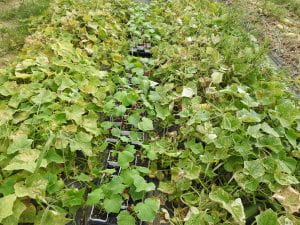
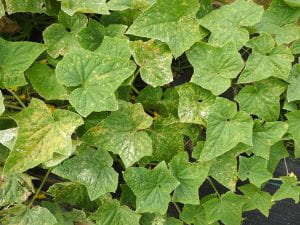
More information/prepared by:
Margaret Tuttle McGrath
Associate Professor
Long Island Horticultural Research and Extension Center (LIHREC)
Plant Pathology and Plant-Microbe Biology Section
School of Integrative Plant Science
College of Agriculture and Life Sciences
Cornell University
mtm3@cornell.edu



